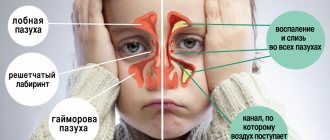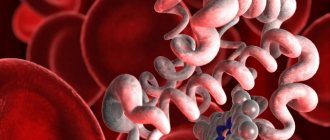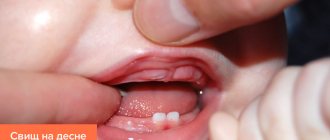Increased moodiness
A baby can be capricious for any reason.
But how can you tell if he’s simply not in the mood or if something hurts? A crying baby often attracts the mother’s attention. But there are times when a child is bothered by worms
All unpleasant sensations will disappear immediately after proper treatment.
If a helminthic infestation occurs in a child, the skin becomes pale and dark circles appear under the eyes. Allergic skin rashes may appear.
Diagnosis of helminthiasis in infants is complicated by the fact that the characteristic symptoms of the disease in almost all cases do not clearly appear. But if your baby experiences all of the above symptoms, this is a clear reason to consult a doctor and undergo a thorough examination. Tests will need to be taken several times, since a regular stool test does not always confirm the presence of worms in the body.
To avoid infecting the child with helminths, the mother must constantly observe the rules of hygiene and monitor the behavior and health of the baby.
For a clearer diagnosis, you should submit only a fresh portion of stool. It is advisable to do this for several days in a row.
If worms are detected in a baby, only a doctor can prescribe treatment. Treatment of children under one year of age also presents some difficulties. Since many anthelmintic drugs have strong side effects, it is not advisable to give them to young children. Self-medication in this situation is prohibited. When the first symptoms of helminthiasis appear, you should immediately consult a doctor.
It is necessary to pay special attention to hygiene, especially in the summer. Children walk a lot, communicate, play in the sand
Therefore, through dirty hands you can easily pick up a helminthic infestation. You should strictly follow the rules of hygiene and monitor all changes in the baby’s health. Then the risk of infection with worms will be significantly reduced.
Be careful!
About helminths can be said:
- restless sleep, grinding of teeth in sleep;
- excessive salivation;
- malaise, increased fatigue;
- allergic skin rashes;
- itching around the anus;
- stomach ache;
- losing weight with a good appetite;
- nausea, swelling, diarrhea or constipation (if helminths have settled in the intestines);
- slight yellowing of the skin (if they have penetrated the liver, which is also not uncommon);
- cough (if they get into the lungs).
However, only every third child has obvious symptoms of the presence of worms. It also happens that he does not complain, and helminths go unnoticed for a long time, but are detected by chance during a stool analysis or when larvae come out of the intestines with feces.
SOS!
Helminthiasis is a fairly serious problem that causes many complications.
The waste products of worms are toxic and often provoke allergic reactions.
The larvae of some helminths can penetrate through the walls of blood vessels into the circulatory system and travel through the bloodstream throughout the body, affecting the liver, lungs, brain, and eyes.
In advanced cases, vitamin deficiency and even protein deficiency develop, which can lead to delayed development of motor skills, mental and speech development.
Under the influence of helminthiasis, immunological reactivity decreases, which often leads to insufficient production of antibodies during vaccination. This makes the prevention of polio, measles, diphtheria, whooping cough, tetanus and other infectious diseases less effective.
If there are a lot of worms, they can clog the intestinal lumen, causing obstruction.
Related news
Study: Blood cells suppress immunity in newborns
How to understand that a child has worms?
Depending on the location of the worms in children, the following signs of the presence of worms in a child may appear:
- Constipation. Large worms can block the intestinal lumen, causing problems with stool passage. Constipation may last more than 2 days.
- Diarrhea. Some parasites secrete a special substance that stimulates the body to excrete undigested pieces of food and large amounts of water.
- Irritable bowel syndrome. Helminths can cause inflammation in the intestines. This causes impaired absorption of nutrients and irregular bowel movements.
- Flatulence. Some types of helminths provoke fermentation processes in the small intestine, which causes excessive gas formation. If you do not get rid of the worms in time, flatulence can last for more than one month.
- Pain in joints and muscles. This occurs when parasites penetrate a joint or deep muscle tissue and destroy it.
- Allergy. The waste products of worms can activate special cells in the body that are responsible for the occurrence of allergic reactions.
- Worms can cause skin diseases. Acne, urticaria, papillomas and diathesis appear. Sometimes infection with worms leads to increased brittleness of hair and nails.
- Anemia. Some types of worms are able to adhere to the intestinal walls and receive from them not only nutrients, but also blood. Because of this, the child develops anemia, which is diagnosed using a clinical blood test.
- Change in body weight. As a rule, as a result of infection with worms, body weight decreases sharply, since the worms absorb more nutrients that enter the body with food. Having a helminth infection often causes loss of appetite due to toxins entering the blood. But often the child experiences an increase in body weight - this is a protective reaction to the spread of worms.
- Disorders of the nervous system. The child has capricious and irritable behavior. Schoolchildren and adolescents may develop depression due to helminthiasis.
- Sleep disorders. When a child wakes up every night, this may indicate an infection is in progress. At night, some types of worms leave the body through the anus, which is accompanied by severe itching that prevents the baby from sleeping.
- Jaundice. More common with tapeworm infections.
- Chronic fatigue syndrome. The child is constantly weak and gets tired quickly due to a lack of nutrients in the body. Memory problems arise, emotional stress and drowsiness develop.
- Immunity disorders. Due to helminthiasis, a child develops diseases of viral origin much more often, and an allergic reaction to ordinary foods appears. Dysbacteriosis and colitis often develop in the intestines, rashes, diathesis and herpes occur on the face.
- Problems with the respiratory system. They occur when worm larvae attack the lungs. With worms, children develop a cough and their body temperature rises. Bronchial asthma is an extremely dangerous complication of worm invasion.
Numerous symptoms of worms in children significantly complicate diagnosis. Therefore, parents should remember about routine preventive examinations, including tests to determine the presence of pinworms and roundworms.
Symptoms of helminthiases
Since helminths go through different stages in their development, the symptoms of these periods have certain differences:
- The acute phase of helminth infections is characterized by allergic skin rashes, inflammation of the lymph nodes, prolonged dry cough, and lobes in the chest. Edema syndrome is observed in trichinosis, up to Quincke's edema. The acute period is characterized by abdominal pain, with paroxysmal colic, muscle weakness, memory loss, and refusal to eat.
- Chronic helminthiasis, symptoms in children smooth out. Poor sleep, learning lag, and vulvitis in girls are observed. Chronic skin diseases develop - psoriasis, seborrhea, dermatitis. Children with chronic helminthiasis often suffer from colds and viral infections due to reduced immunity.
Prevention measures
The most important way to prevent worms in children under one year of age is strict adherence to hygiene rules not only by the mother, but also by all family members. Even guests who come to visit a child must wash their hands thoroughly before approaching him.
Prevention of worms in infants requires compliance with the following rules:
- careful processing of vegetables, fruits and herbs;
- regular cutting of nails (mother and child);
- regular diaper changes;
- ironing baby clothes on both sides;
- regular washing of toys;
- prevention of helminthiasis in pets;
- daily wet cleaning of the premises with treatment of all surfaces;
- Meat and fish should be cooked for at least an hour.
Compliance with preventive measures by all family members will help avoid infecting an infant with parasites.
If you follow preventive measures, you can avoid infecting children under one year with worms. In addition, following basic hygiene rules will protect your baby from many other diseases. If infection does occur, you must immediately see a specialist who will prescribe adequate treatment. After treatment, probiotic therapy will be needed to restore immunity and intestinal microflora.
What do different worms look like?
As stated above, 70 types of parasites are found in Russia, however, most often infection occurs with one of 10 types of helminths, and they look like this.
| Type of parasite and photo | Caused disease | Description of appearance |
| Pinworm | Enterobiasis | Small, round worms up to 10 mm. |
| Roundworms | Ascariasis | Long, about 6 cm, round specimens, red and white in color, crocheted. |
| Toxocara | Toxocariasis | Large up to 10 cm, round parasite, yellowish in color. |
| Trichinella | Trichinosis | Small, up to 5 ml, round, burgundy worm. |
| Whipworm | Trichocephalosis | The parasite is thinner on one side than the other, 5 cm long. |
| Bull tapeworm | Teniarinhoz | A long individual, with a small head and a ribbon-like body. The size can reach 30 meters. |
| Pork tapeworm | Teniosis, Cysticercosis | The appearance is similar to the bull tapeworm, but its length is shorter, about 5 meters. |
| Echinococcus | Echinococcosis | Small up to 11 mm, tape parasite with suckers on the head. The body of the worm consists of several links. |
| Wide tapeworm | Diphyllobothriasis | The length of a flat, tapeworm is up to 10 meters. |
| Giardia | Giardiasis | Detectable only under a microscope. Some individuals move with the help of flagella, others are immobile. |
| Cat fluke or Siberian fluke | Opisthorchiasis | A small individual, does not reach more than 10 mm, the head of the parasite has a suction cup. |
Whipworms - what they look like in the human body
This type of parasite is quite rare in central Russia. Whipworms often live in the southern regions, since the eggs of this worm love warmth. Most infections are observed in rural areas. Whipworm eggs live in the soil.
Infestation occurs through hands, contaminated soil particles, and poorly washed vegetables and fruits. As a result of infection, a disease occurs - trichocephalosis. Whipworm parasitizes the intestines. This worm causes anemia, as it feeds on human blood, and severe abdominal pain.
To diagnose trichuriasis, the rectum and sigmoid colon are examined with a special device (sigmoidoscopy). In this way, accumulations of parasites in the intestines are detected. Treatment of the infestation takes a long time, since the whipworm eggs are protected by a dense shell.
The eggs of the parasite are excreted in the feces, but they are very small and cannot always be seen even under a microscope. Only with very severe infestation is it possible to detect eggs in a stool test. They are shaped like a barrel and have a brownish-yellow color.
There are holes on both sides of the egg. What do worms look like in feces? They are very difficult to detect alive in feces, since whipworms cannot live long outside the human body. Only with anthelmintic therapy can you notice dead white worms in the feces.
Symptoms and consequences of helminthic infestation
The children's body is more often disturbed by representatives of nematodes (pinworms, roundworms). Among the main symptoms that should alert parents if they suspect ascariasis are the following:
- Problems with the gastrointestinal tract (constipation, diarrhea, abdominal pain, increased gas formation, lack of appetite).
- Increased size of the liver, spleen, lymph nodes.
- Rashes (urticaria, allergic dermatitis), pigmentation (yellowness) of the skin.
- Itching and redness of the anus.
- Neuropsychic disorders in the form of short temper, increased excitability, moodiness, restless sleep.
- Increased body temperature.
Enterobiasis (infection with pinworms) also causes a number of symptoms:
Restless sleep
- Restless sleep, grinding teeth, talking in your sleep.
- Severe itching and hyperemia in the anal ring.
- Weight loss or growth retardation with a normal diet.
- Fatigue, weakness, drowsiness.
- Headaches, dizziness.
- Nervous and neurological disorders (weak memory, absent-mindedness, tearfulness, irritability).
- Enuresis, vulvovaginitis in girls, which is due to the close location of the anus, vagina and urethra.
- Abdominal pain, intestinal disorders, vomiting, loss of appetite.
- Reduced level of hemoglobin in the blood, vitamin deficiency.
- Causeless dry cough.
- Decreased immunity.
Modern medicine offers a wide choice. Despite the fact that it is not difficult to get rid of worms with the help of medications, you should not delay treatment. In advanced cases, parasites are able to settle not only in the gastrointestinal tract, but also penetrate through the blood into the lungs, brain, liver and other organs, causing serious harm to the small organism. The consequences of helminthic infestation in children can be:
- development of allergic reactions up to bronchial asthma;
- decreased efficiency of the digestive system;
- immunodeficiency conditions in which the child often catches colds and develops chronic respiratory diseases (rhinitis, bronchitis, tracheitis, pneumonia);
- toxic damage to internal organs;
- retardation in mental and physical development.
It also happens that worms do not manifest themselves in any way. Then only laboratory tests will help diagnose the colonization of the body by parasites.
Diagnosis of helminthic infestation in children
As can be seen from all of the above, helminthic infestation in children is very common, its symptoms are very diverse. It can easily be confused with many other diseases, which is why timely and correct diagnosis of the disease is so important. To make an accurate diagnosis, in most cases, pediatricians prescribe two main research methods:
- Analysis of feces for the presence of worms and their larvae, sometimes to detect worms it is necessary to carry out the analysis several times;
- Blood analysis.
Types of helminths
There are several types of parasites that can settle in a child's intestines. They differ in color, size, and the nature of their effect on the body. Moreover, the larger these parasites, the more dangerous they are for the body of a small child, since they release much more toxins.
Many parents assume that their child may only develop pinworms, but this is a misconception, since the child can also become infected with other, more dangerous parasites.
In children, the intestines may appear:
- Pinworms, which are small worms, up to 5 mm long, while females grow up to 12 mm in length. Pinworms are distinguished by their gray-white hue and rounded-elongated body shape. They prefer to live in the cecum and small intestine.
- Roundworms are already larger parasites, reaching a length of 25 to 40 cm, depending on gender. They are distinguished by a rounded body shape and pointed ends. As a rule, they live in the area of the small intestine.
- Whipworms are medium-sized parasites, up to 5 cm long. They are distinguished by a body divided into two parts: one part is wide, and the other is thread-like. These parasites live and reproduce in the large intestine.
How can a child become infected with worms?
Worms in babies. Infection with worms (invasion) occurs when eggs or larvae of worms enter the body. Worm eggs enter the environment with the feces of infected people and animals. The eggs are microscopic in size, very resistant to various influences and can remain viable for a long time outside the body (in the soil, on the surface of objects or products, in the folds of linen, on the skin). When worm eggs enter the baby’s oral cavity, they pass, partially destroyed, through the acidic, aggressive environment of the stomach and are activated in the intestines, where the conditions for the development of adult individuals from eggs are favorable. Infants and preschool children are especially susceptible to helminthic infestations, since their protective barriers of the gastrointestinal tract are not yet perfect.
A baby can become infected at home, on a walk, at a party or in kindergarten through contact with contaminated surfaces or objects (street shoes, hallway floors, toys, common areas), on the street (picking up any objects, playing in a sandbox or on the ground ), as well as in contact with animals (especially stray or domestic animals that are on the street).
There is a very high probability of worms appearing if the rules of basic hygiene are not followed (unwashed hands, eating unwashed vegetables and fruits, drinking raw water from natural reservoirs, etc.).
Considering the possibility of infection with helminths, we draw the attention of parents to preventive measures:
- Until the baby begins to move around the apartment on his own, a mandatory rule for adults and older children should be to thoroughly wash their hands with soap after going outside or visiting the restroom before contacting the child or his things, try to avoid close contact of the baby or his things with pets;
- when the child begins to crawl or walk around the house, do not allow him into the hallway and restroom, and do not allow him to play with outdoor shoes;
- on the street, make sure that the child does not pick up or put various objects into his mouth, do not allow contact with stray animals, and, if possible, do not let the child play in open (not fenced) sandboxes;
- using gentle pedagogical influence, wean the child from the habit of putting various objects in his mouth or licking his fingers, accustoming the child to personal hygiene (teaching to wash hands with soap after going outside and going to the restroom);
- periodically carry out wet cleaning at home using detergents and disinfectants, wash toys with soap, vacuum soft toys, carpets, etc.;
- Do not give your child or consume unwashed vegetables and fruits, thermally unprocessed meat and fish, or raw water from natural reservoirs.
Compliance with these rules does not provide a 100% guarantee, since the child is actively exploring the world and it is not always possible to follow him, but these precautions significantly reduce the likelihood of infection with worms
Prevention of worms in children
- Wash all fruits, vegetables, berries, herbs thoroughly;
- Meat and fish should be cooked for at least 40-60 minutes;
- You should fight flies, mosquitoes, cockroaches by any means;
- If you have pets, they should be dewormed regularly, regardless of whether they have symptoms of worms or not;
- Teach your child to wash their hands with soap after any contact with an animal;
- Keep pacifiers, nipples, and toys clean; if a child drops them, do not give them to him without first washing them;
- First, you should constantly ensure that the baby washes his hands after going outside, using the toilet, after playing, and most importantly, before any meal;
- Wean children from the habit of biting their nails, sucking fingers, and putting pens, pencils, and markers in their mouths. A child’s nails should always be clean and short;
- To avoid re-infection with pinworms, dress your child in thick, tight-fitting panties at night, this will reduce the spread of pinworm eggs on the bedding;
- After each wash, be sure to iron your panties and T-shirt. It is in the morning that you should change your panties and thoroughly wash your baby’s bottom. It is advisable to do this in the evening.
Treatment
Worms cannot go away on their own, so the child must be treated. Treatment is prescribed by the doctor based on the results of the analysis. It is not recommended to treat a newborn yourself, since many drugs are contraindicated in children under 2 years of age. Only the attending physician can choose an effective and safe treatment regimen for your baby.
Treatment of children aged 2 years and older may include drug therapy and folk remedies. As a conservative treatment, doctors prescribe the drug Nemozol and Pyrantel.
If the test results show that the child has worms, then there is no need to panic. If treatment is started in a timely manner, the parasites will not be able to harm the baby’s health.
Folk remedies are the safest for a child, since they have a more gentle effect and do not cause allergies. Pumpkin seeds are good at cleansing the body of worms. Grind dry pumpkin seeds in a coffee grinder. The resulting powder can be added to baby food or milk. Start with small doses. The minimum dose is on the tip of a teaspoon. Gradually the amount of powder can be increased. The course of treatment is 3-4 weeks.
Mechanical cleansing of the intestines from parasites can be carried out using walnut peels. The principle of treatment is similar to pumpkin seeds.
The solution should be weak. Along with the feces, worms and their metabolic products will be released. This procedure should not be abused, since useful and nutrients leave the body along with toxins.
To prevent the baby from becoming infected with helminths, parents must follow preventive measures. It is mandatory to observe the rules of personal hygiene for both the newborn and the parents. If you have pets, regularly prevent helminthiasis. Make sure your child does not put dirty objects or food in his mouth. Such measures will significantly reduce the risk of infection.
Treatment of worms in children
Before selecting treatment, the pediatrician must diagnose the disease and determine what type of helminth is present in a particular case. To do this, it is recommended to test stool for eggs/larvae of worms more than once, but for 3 days in a row. Based on the data obtained, a set of indirect symptoms and the exclusion of other pathologies that cause a similar clinical picture, the child, and sometimes all family members, are prescribed anthelmintic therapy in order to avoid the formation of a focus of infection. It means:
- preparation for the removal of parasites;
- treatment directly aimed at eliminating helminths;
- elimination of painful symptoms;
- restoration of the functioning of the immune system, gastrointestinal tract and other organs whose function has been impaired by worms.
As preparatory means, parasitologists, infectious disease specialists, pediatricians and other specialists who help cure helminthic infestations use vegetable oils such as flaxseed and pumpkin. They quickly bind all toxic substances that were formed as a result of the vital activity of helminths and remove them from the body. Enterosgel can be prescribed from pharmaceutical sorbents. It is harmless and non-toxic, and therefore is freely given to children even from the first month of life.
For the treatment of worms, drugs are selected taking into account the pathogen. Most often these are broad-spectrum medications. Eg:
1. Decaris - tablets that cause paralysis of the muscles of roundworms, pinworms, whipworms and about 5 other types of helminths; The children's release form has a pleasant apricot smell and light orange color, which “interests” the child in taking the medicine.
2. Pyrantel is a drug for the treatment of enterobiasis, trichuriasis, ascariasis, necatoriasis (caused by the necator worm) and hookworm disease (hookworms); effectiveness is achieved through neuromuscular blockade of parasites; Children are usually prescribed in the form of a cloudy yellow suspension.
3. Vermox is a white or beige tablet product that is used for the treatment and prevention of infection by pinworms, roundworms and other ill-wishers; it is also often prescribed for mixed helminthiases; It has a detrimental effect on worms by depleting the glycogen supply in their tissues.
Since symptoms and treatment are inseparable concepts in medicine, therapy is required to combat individual manifestations of the disease. For example, he may be prescribed antihistamines (Suprastin, Diazolin), mucolytics and bronchodilators (Bromhexine, Ambrobene, Mucaltin), antispasmodics (Papaverine), iron supplements (Irovit, Venofer - for anemia).
Medicines designed to maintain and restore natural microflora (Bifiform, Linex) will help treat gastrointestinal dysfunction caused by worms. Milk thistle products (Geparsil, Darsil) will help normalize liver function. In order to increase immunity, children are prescribed multivitamin complexes (Alphabet, Vitrum Baby) and immunostimulants (Immunal, Transfer Factor Kids).
Surgical treatment is used extremely rarely, only in the following cases:
- prolonged spasm of the small intestine due to the presence of dead roundworm in it;
- blockage of the child’s bile ducts by worms;
- perforation of the intestinal wall by helminths; acute appendicitis caused by parasites clogging the appendix.
How does infection occur?
Do babies have worms? Any doctor will answer this question positively. Of course, one cannot say that this phenomenon occurs often, because the baby has a rather limited circle of friends. But the occurrence of helminthic infestation in infants cannot be completely ruled out.
Worms in a child (one-year-old child) can appear due to eating unwashed fruits and vegetables, failure to comply with personal hygiene rules, or as a result of contact with animals. Parasites also enter the baby’s body through a dirty pacifier or teether.
Often the cause of worm infection is the baby’s habit of putting everything in his mouth.
The most common causes of helminth infection in infants:
- Mother has worms. Infection can occur during breastfeeding or caring for a baby.
- Eating food made from poorly processed foods (meat, fish, vegetables, fruits, etc.).
- Failure of parents to comply with basic hygiene rules (long nails, dirty underwear and bed linen, unwashed hands, dirt in the room, etc.).
- Games with pets.
Causes of worms in children
Ascariasis is a disease the main causative agent of which is roundworm, a roundworm that parasitizes the intestines of animals and humans. The main reasons for the appearance of roundworms in a child:
- close communication with pets;
- eating unwashed vegetables and fruits;
- neglect of personal hygiene rules after visiting the street, before eating.
Ascaris eggs can be contained in street dust, present on the fur of animals - dogs and cats, or on human skin.
Enterobiasis is a disease caused by pinworms - small roundworms reaching a size of no more than 1 cm, the main habitat of which is various parts of the intestines of animals and humans. The main source of these helminths is a sick person. Children often become infected with enterobiasis from each other in the process of playing together, sharing toys, dishes, and clothes. Pinworm eggs can enter the human body along with inhaled dust when eating unwashed vegetables.
Giardiasis is a disease caused by infection with protozoan worms, Giardia, that live in the small intestine. The main source of Giardia in nature is soil, particles of which, together with worm eggs, end up on food products. A child can become infected with Giardia by eating poorly washed and unheat-treated vegetables, playing in the sandbox, or interacting with other children.
The main cause of intestinal helminth infection in a child of any age is, as a rule, lack of personal hygiene. Less commonly, children become infected with worms (tapeworms, echinococci), the eggs of which are contained in improperly prepared fish or meat dishes.
Symptoms and their classification
signs of helminths
All symptoms can be divided into indirect and direct:
- direct signs of worms are noticeable at the age of 8-12 months with a strong infestation of parasites, they are clearly visible and hard to miss;
- indirect signs of worms in an infant are almost invisible, most likely it could be other diseases.
As numerous recent studies have shown, if a mother feeds her baby with her milk, then the risk of parasite infection in the child is much lower. Because his immunity is stronger than that of one who is on artificial nutrition. The intestines and stomach from mother's milk become stronger and cope better with parasites and various microbes. According to many doctors, breastfeeding is the best prevention for infants against worms; helminths in this case really have little chance of survival.
Direct symptoms
How to identify worms in children under one year of age, when symptoms practically do not appear? You can have your stool tested, but in practice, only half of the tests in infected children will be positive: pinworms in a child do not always show up in their stool. There may be several reasons for this:
- firstly, pinworms lay their eggs on the skin, and not in the intestine itself;
- secondly, the stool must be fresh; even an extra half hour plays a big role in laboratory analysis.
The main symptoms of pinworms and some other types of worms in a child:
- constant crying and capricious character, although the child is completely surrounded by care and does not need anything;
- nervous sleep - systematic waking up during the day or at night is caused by worms; helminths can significantly change the baby’s rhythm of life;
- constant stool disorders: diarrhea can quickly give way to constipation and vice versa;
- itching around the anus, usually this occurs at night or in the morning;
- circles around the eyes and coating on the tongue indicate a health problem in children of any age, even well over a year;
- During sleep, the baby notices strong salivation;
- despite a good appetite, there is weight loss. The worms take all the beneficial substances for themselves, leaving nothing for the baby.
If a baby has pinworms, the symptoms listed above may appear one at a time or several at once. The more of these signs your child has, the higher the chances that he already has worms.
Symptoms of an indirect nature
helminths are detected in the laboratory
- the allergy manifests itself immediately after the intestines are damaged by worms. As they grow, harmful substances are released; worms infect the microflora with their toxic waste products. This leads to the fact that food is less digestible, the intestines cannot cope with the load, and the child exhibits allergic reactions;
- low immunity is also associated with the release of harmful substances in the intestines. Worms in a child begin to disrupt the immune system, a small amount of useful substances enters the body, they are replaced by toxic substances from the decay of parasites.
Traditional methods of treatment
Traditional medicine offers effective and safe remedies for worms for children. They help improve the baby’s overall well-being, metabolism, and normalize the activity of many body systems, increasing protective functions. All this leads to the expulsion of helminths, making their residence in the intestines uncomfortable.
The advantage of medicines prepared using ancient recipes is their safety, which allows them to be safely used at the first sign of worms in an infant. Before use, you should consult your doctor so that you can choose the correct dosage of the medicine and determine the duration of the treatment course.
Pumpkin seeds have a high antihelminthic effect
They have a pleasant taste, which is important for children. Dry seeds are thoroughly crushed without removing the peel (you can use a coffee grinder for this)
The resulting powder is added to applesauce, porridge, and diluted with milk or water. For successful treatment, the anthelmintic is administered gradually. Under the influence of active substances, helminths die off.
If there are a large number of parasites, the child’s body may not be able to cope with their elimination, resulting in intoxication. Its symptoms are similar to colds - the child experiences redness of the throat and snot. Compliance with the required dosages of the antihelminthic agent used will help eliminate the manifestation of intoxication. Pumpkin seed powder is given on the tip of a teaspoon in the first two days, then gradually increased every day to ¼ spoon, continuing to use this dose for 21 days. Pumpkin has no side effects or contraindications, therefore it is one of the most popular remedies for treating worms in infants.
Linseed oil
Hemp, flax or pumpkin oil helps in the fight against pinworms. Reproduction of worms occurs in the anus and perineum, where the female lays eggs at night. This can be prevented by covering the anus with a cotton swab soaked in oil while sleeping for 40 nights in a row.
Worms do not like carrot and beet juice. Garlic is an effective remedy against helminths of various types. Mash three cloves into a paste, dilute in a glass of milk and give to the baby little by little for three days.
Mechanical cleansing of the intestines using a garlic enema helps in getting rid of worms in children under one year of age. Pour boiling water over the garlic cloves and cool. Strain before use. The enema temperature should be room temperature, the volume should be 50–100 ml depending on the age of the child. Doctors advise giving the baby warm water or carrot juice before the procedure.
It is possible to defeat parasites!
Antiparasitic Complex® - Reliable and safe removal of parasites in 21 days!
- The composition includes only natural ingredients;
- Does not cause side effects;
- Absolutely safe;
- Protects the liver, heart, lungs, stomach, skin from parasites;
- Removes waste products of parasites from the body.
- Effectively destroys most types of helminths in 21 days.
There is now a preferential program for free packaging. Read expert opinion.
Read further:
Signs of worms in children aged 2 years: how to determine the presence of parasites in a baby
What worms look like in children: roundworms, pinworms, flukes and tapeworms
What do worm larvae look like: round and tapeworms, flukes
At what temperature do the eggs of worms (roundworms) and pinworms die?
What worms can you get from a cat: a list of common cat worms
Signs and treatment of worms in adults and children, symptoms of the presence of parasites
Causes
Many parents wonder whether there could be parasites or worms in their infants? This question can be answered by knowing the routes of infection by this invasion. The nature of transmission of worms in a one-year-old child or adult is the same - it is the fecal-oral route. That is, for infection it is necessary that the eggs and larvae of the parasite enter the oral cavity and be swallowed. They mature in the body, migrate, spreading throughout all systems and organs, and begin to actively develop, causing corresponding symptoms.
Worms can appear in infants for the following reasons:
Parents' failure to maintain hygiene. Failure to wash hands in a timely manner can result in parents leaving eggs and larvae of parasites under their nails and on their skin. When communicating with a child, they can get into his mouth. This leads to the development of worms in infants; An 8-month-old child or an adult may develop parasites after drinking contaminated water. Larvae and eggs are able to survive for a long time in water outside the host’s body. They not only remain viable, but also develop in water. May be present both in water in natural reservoirs and in insufficiently purified tap water.
Drinking such unpurified liquid leads to intestinal parasites in a child under 1 year of age; When including homemade vegetable purees in the diet, in order to prevent worms from appearing in children under one year of age, it is important to thoroughly wash the vegetables and fruits. If the vegetable grew on contaminated soil, then most likely it contains a fairly large number of eggs and larvae
If such a product is not washed thoroughly enough, its consumption leads to the development of an infestation in a child 7 months or older; You should also be careful when preparing meat purees for your baby. Eggs and larvae may also be present in the meat (if the animal was infected or the larvae got there as a result of violation of storage rules). In this case, the parasites can be killed by long-term freezing of the meat or by thoroughly heat treating it. If the meat is cooked poorly or insufficiently, the child may develop worms; Sometimes an 11-month-old child may develop worms after interacting with pets. Dogs and cats that are outdoors are almost always infected with worms, even if they are given regular preventative care. Prolonged and close contact with such pets (for example, a dog licking a child’s face and hands) leads to infection with parasites; Another reason for the appearance of worms in infants is insects. They are capable of carrying infestation larvae and eggs on their paws and body. By sitting on food or the body of a baby, they leave sources of infection on them. This is an unlikely route of infection since the amount of pathogen that can be transferred this way is very small. However, such an infection is theoretically possible.
There is debate among scientists about whether worms in the mother can cause them to appear in the baby. Theoretically, this route of infection is possible, since the larvae are able to travel through the bloodstream and enter the baby’s body through the placenta, which is not always able to cope with the body’s defenses. For this reason, worms in infants occur quite rarely, however, sometimes it happens.
How parasites enter the human body
They enter the human body in different ways, most often through the consumption of contaminated water and food.
Pinworm eggs remain viable for up to 6 months and enter the body through toys, carpets, underwear and bedding. Ascaris eggs get inside us through poorly washed vegetables and fruits. Shish kebab or homemade lard is a 95% guarantee of infection with trichinosis.
Parasites penetrate inside us through insect bites, when swimming in freshwater bodies, through the air, and through dust, which carries eggs.
Salted fish, stroganina or caviar are the cause of infection with a tapeworm, the length of which reaches 12 meters and which can live in your body for up to 25 years. Cases of infants becoming infected with parasites in the womb have become more frequent. Dogs and cats, through their moist breath, can disperse parasite eggs at a distance of up to 5 meters.
You can become infected through dirty hands, not only your own, but also sellers, cooks, waiters; parasite eggs travel on money and handrails of public transport. A high concentration of parasite eggs is observed in products such as: bacon, smoked sausage, ham, sausages, pork of any form, beef, chicken, lamb, and even chicken eggs are very often contaminated with them.
Epidemiologists around the world are trying to fight this scourge. In the USA, for example, 1 pig carcass out of every thousand is destroyed to test for helminthiasis. This adds up to multimillion-dollar losses, but there is no other way.
There are no absolutely reliable methods for disinfecting meat, and ordinary cooking does not destroy the larvae. You cannot guarantee the purity of your food by boiling or frying meat; a huge number of parasite larvae still penetrate your body.
A child has worms - what to do?
After the diagnosis has been confirmed, the doctor prescribes treatment for worms in children; drugs should be strictly coordinated with the doctor), talks about folk methods and products that should be consumed for a quick recovery. Parents should know that they should not give medications to their children on their own, as this can lead to irreversible consequences and thereby worsen the child’s condition.
If you do not know how to get rid of worms in children, then contact a specialist who will describe several stages of therapy for you. These include:
- preparing the body - in this case, sorbents (Smecta, Entegnin) and antihistamines (Diazolin, Suprastin) are prescribed;
- anthelmintic therapy - traditional drugs for parasites, which can be in the form of tablets, suppositories or suspensions;
- cleansing the body - enemas, choleretic drugs or sorbents.
Treatment of worms in children is carried out at home, unless there are any complications in the form of infectious lesions. Throughout the entire period, the child must follow a special diet. After the first course of therapy, the child is examined and tested again. If they again show the presence of parasites in the body, then the drugs are prescribed again.
Deworming tablets for children
Currently, there are several medications that help get rid of helminths. They are available in tablets and are intended for children. The most effective anti-worm medications for children:
- Kombantrin or Helmintox;
- Wormil or Albendazole;
- Vermox or Mebendazole.
Anti-worm suspension for children
If your child is still small and does not know how to take pills, then specially developed suspensions are suitable for him. The most effective drugs are:
- Piperazine is an anti-worm medicine for children that affects both larvae and eggs;
- Pyrantel - the drug is taken in a course with a break of 2 weeks.
Folk remedies for worms in children
With the help of traditional medicine you cannot completely get rid of parasites, but you can boost your immunity and speed up treatment. Deworming medicine for children should be taken carefully and only with the permission of a doctor. The most popular products are:
- garlic;
- pumpkin seeds;
- carrot juice;
- vegetable oil;
- infusions of celandine and wormwood or tansy.
Treatment with folk remedies
With the help of folk remedies you cannot completely get rid of parasites, but you can speed up the treatment process and boost your immunity. There are several recipes that are extremely useful for worms.
- Pumpkin seeds. Pumpkin seeds have a negative effect on worms and promote their release, while improving digestion. A few hours before breakfast on an empty stomach you need to eat a small handful of seeds - this should be done every day until complete healing.
- Garlic. Garlic essential oils have a detrimental effect on parasites, so it is recommended to eat it in case of helminthic infestations. It is enough to eat a few cloves with a bite of black bread before breakfast to notice the positive effect.
The best effect can be achieved by combining folk remedies and medications. It is also important to follow all the rules of personal hygiene, otherwise the disease will recur. In general, the prognosis for pinworms and roundworms is favorable: with proper treatment, these parasites go away fairly quickly.










